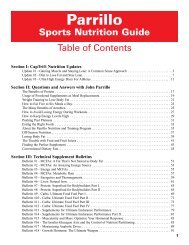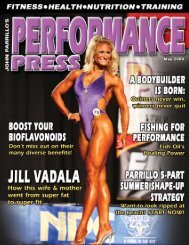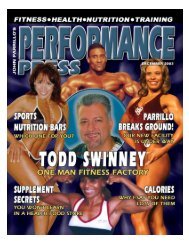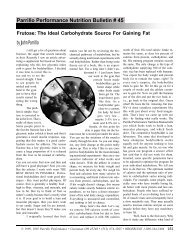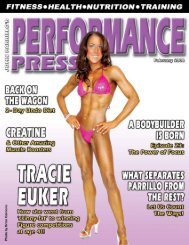A Monthly Magazine For All Bodybuilding, Fitness And - Parrillo ...
A Monthly Magazine For All Bodybuilding, Fitness And - Parrillo ...
A Monthly Magazine For All Bodybuilding, Fitness And - Parrillo ...
Create successful ePaper yourself
Turn your PDF publications into a flip-book with our unique Google optimized e-Paper software.
MEDIUM CHAIN TRIGYLCERIDES & THE LOW CARBOHYDRATE DIET<br />
has built-in defense mechanisms to guard against starvation<br />
and as far as your body is concerned, a low calorie<br />
diet is just slow starvation. In response, the body hoards<br />
it’s fat stores – exactly what we don’t want!<br />
It works best to supply your body with plenty of<br />
energy for training and recovery. But this energy need<br />
not necessarily be carbohydrate-derived energy. If we reduce<br />
carbohydrate intake, what should we eat instead?<br />
Medium chain triglycerides, like CapTri ® , are technically<br />
fats, but they’re very special fats. Due to their unique<br />
molecular structure MCT’s are rapidly burned as fuel and<br />
have almost no tendency to be stored as body fat. Most<br />
fats and oils contain fatty acids that are 16 to 18 carbon<br />
atoms long. This long hydrocarbon chain makes them insoluble<br />
in water. (You will recall oil and water don’t mix.)<br />
<strong>For</strong> this reason conventional fats follow a complicated<br />
and somewhat circuitous metabolic pathway. When you<br />
eat a fat, such as olive oil or butter for example, the triglyceride<br />
molecule is taken apart by an enzyme made by the<br />
pancreas called pancreatic lipase. The fatty acids then are<br />
able to pass through the membranes of the intestinal cells.<br />
There, they are reattached to the glycerol backbone and<br />
combine with proteins to form large molecular aggregates<br />
called chylomicrons.<br />
Proteins act to help make the fat more soluble in water<br />
(like detergent) so the fats can enter the bloodstream without<br />
clogging up arteries. The chylomicrons enter the lymphatic<br />
system (a series of vessels similar to veins) which<br />
transports tissue fluids. The chylomicrons travel through<br />
the lymphatic until they reach the thoracic duct in your<br />
neck. This is where the contents of the lymphatic system<br />
enter the bloodstream. From there the fat is carried to fat<br />
cells for storage. Another lipase enzyme in the capillaries<br />
breaks down the triglyceride again and the fatty acids<br />
enter the fat cells for storage. They remain there until you<br />
need to use fat as fuel. Your body will use carbohydrates<br />
as fuel as long as it can and will do so in order to save<br />
bodyfat. Adipose depots are like fuel reserves that your<br />
body hangs onto to for use when there is no food. As a last<br />
resort, to ward off starvation, the body will emulsify fat from<br />
storage – not before. The body preferentially burns carbohydrates<br />
until your blood sugar starts to drop. Insulin levels<br />
go down and the fat cells release fatty acids to be used as<br />
fuel. You should notice this pathway of metabolism for fat is<br />
different from that followed by other nutrients.<br />
Carbohydrates and proteins do not enter the lymphatic<br />
system but go directly into the bloodstream. <strong>All</strong> of<br />
the blood that leaves the small intestine is collected into a<br />
big vein called the portal vein that goes to the liver. After<br />
your small intestine absorbs the protein or carbohydrate,<br />
the conglomerate goes directly to the liver where it is used<br />
for energy and to make vital proteins. Afterwards, the remainder<br />
is released into general circulation. Conventional<br />
fats enter the bloodstream via the lymphatic system and<br />
bypass the liver. Dietary fats are preferentially stored in<br />
adipose depots before they are metabolized as fuel. MCTs,<br />
though technically a fat, behave completely differently.<br />
Since they are more soluble in water they don’t need to<br />
be incorporated into chylomicrons. Nor do they enter the<br />
lymphatic system. Instead, they enter the bloodstream directly,<br />
like a carbohydrate, and are transported to the liver<br />
by the portal vein. MCT’s are rapidly oxidized as fuel.<br />
Almost no medium chain triglyceride molecules escape<br />
the liver. The molecules are broken down into small<br />
fragments of fatty acids called ketone bodies. These ketone<br />
bodies are released into the bloodstream where they<br />
are taken up by muscles and used as fuel. Notice that<br />
MCTs are not stored in fat cells and don’t contribute to<br />
fat accumulation. Instead they are rapidly oxidized as fuel.<br />
Best of all, they do not elicit a big insulin response. <strong>All</strong> of<br />
these properties taken together make CapTri ® an ideal<br />
source of energy to use when you’re cutting back on<br />
carbs. CapTri ® helps you maintain a low insulin environment<br />
and shifts your metabolism into a fat-burning mode<br />
instead of a carbohydrate-burning mode. CapTri ® provides<br />
a replacement for reduced carbohydrates without<br />
reducing calories and thereby activating your body’s starvation<br />
response. You can reduce carbohydrate cravings<br />
and still maintain your energy level.<br />
CapTri ® works well as a salad dressing, in soups, on<br />
chili, as a barbecue sauce and so on. We have an outstanding<br />
CapTri ® Cookbook that contains over eighty recipes<br />
and shows how to incorporate CapTri ® in everything from<br />
homemade soups to biscuits to fried fish. Increase your<br />
use of CapTri ® gradually until you match the number of<br />
calories that you have reduced in carbohydrates. CapTri ®<br />
has 114 calories per tablespoon and used judiciously will<br />
melt off the fat faster than you’d imagined possible!<br />
References<br />
1. Baba, Bracco, and Hashim, Enhanced thermogenesis<br />
and diminished deposition of fat in response to overfeeding<br />
with diet<br />
containing medium chain triglyceride. Am. J. Clin.<br />
Nutr. 35: 678-682 (1982).<br />
2. Bach and Babayan, Medium chain triglycerides:<br />
an update. Am. J. Clin. Nutr. 36:950-962 (1982).<br />
3. Christensen, Hagve, Gronn, and Christophersen,<br />
Beta-oxidation of medium chain (C8-C14) fatty acids studied<br />
in isolated<br />
liver cells. Biochem. et Biophys. Acta 1004: 187-195<br />
(1989).<br />
4. Geliebter, Torbay, Bracco, Hashim, and Van Itallie,<br />
Overfeeding with medium chain triglyceride diet results<br />
in diminished<br />
deposition of fat. Am. J. Clin. Nutr. 37: 1-4 (1983).<br />
5. Mascioli, Bistrian, Babayan, and Blackburn, Medium<br />
chain triglycerides and structured lipids as unique<br />
nonglucose energy sources in hyperalimentation. Lipids<br />
22: 421-423 (1987).<br />
6. Record, Kolpek, and Rapp, Long chain versus medium<br />
chain length triglycerides - a review of metabolism<br />
and clinical use. Nutr. Clin. Prac. 1:129-135 (1986).<br />
Info-Line: 513•531•1311 John <strong>Parrillo</strong>’s Performance Press • March 2000 21




